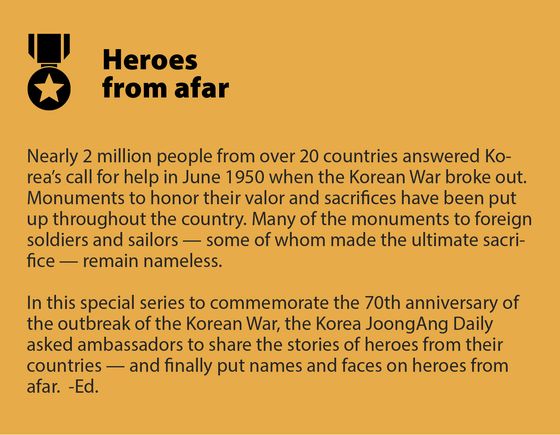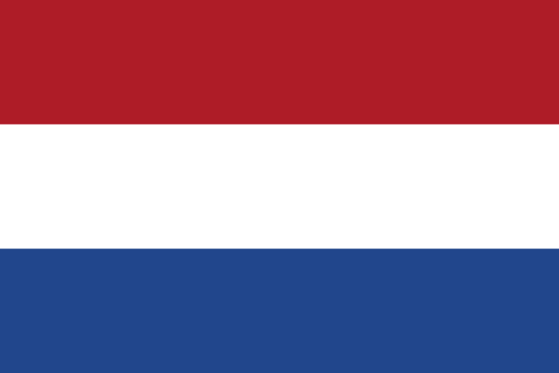[Heroes from afar] Dutch troops volunteered on Korean War front line
![Joanne Doornewaard, ambassador of the Netherlands to Korea, in an interview with the Korea JoongAng Daily on Dec. 3. [PARK SANG-MOON]](https://koreajoongangdaily.joins.com/data/photo/2020/12/27/763ac6ca-ada0-4271-bb43-a2d74a7b7297.jpg)
Joanne Doornewaard, ambassador of the Netherlands to Korea, in an interview with the Korea JoongAng Daily on Dec. 3. [PARK SANG-MOON]
South, Netherlands still working to recover remains of the missing

“Battles were fierce, but sometimes we had relatively cordial contacts with our enemies,” wrote Kelders to the Korea JoongAng Daily on Dec. 3. “We used to wave at them and, unarmed and wearing armbands, could recover our wounded.”
Kelders was a Browning automatic rifleman with the Netherlands’ Van Heutsz Regiment. On Jan. 8, 1952, he arrived in Korea at the age of 23.
Like the 4,747 other Dutch soldiers who came to the aid of South Korea during the war, Kelders volunteered to fight for South Korea.
“Because North Korea received help from China and was supported by Russia in the background, I wanted to help South Korea win this war and stop communism,” he said.
![Antonius Johannes Kelders, a Dutch corporal during the Korean War. [ANTONIUS JOHANNES KELDERS]](https://koreajoongangdaily.joins.com/data/photo/2020/12/27/8cd3716a-34f5-4cd4-994f-a7a2361b10c1.jpg)
Antonius Johannes Kelders, a Dutch corporal during the Korean War. [ANTONIUS JOHANNES KELDERS]
“It was not an easy decision when the United Nations called for [assistance in Korea],” said Joanne Doornewaard, ambassador of the Netherlands to Korea, in an interview with the Korea JoongAng Daily on Dec. 3. “But we decided to contribute to the defense of South Korea and made a call for volunteers. There were more volunteers than were expected, so many soldiers registered.”
The first batch of Dutch ground forces left for Korea on Oct. 27, 1950, and landed in Busan on Nov. 23, 1950.
Dirk Frederik Hermans, a 23-year-old private first class arriving in Busan at the time, said the general scene could be summed up into two colors.
"It was grey, and it seemed to me like everyone was walking around in white suits," he wrote to the Korea JoongAng Daily on Dec. 3.
![Dirk Frederik Hermans, a Dutch veteran of the Korean War, shortly before leaving for Korea in 1950. [DIRK FREDERIK HERMANS]](https://koreajoongangdaily.joins.com/data/photo/2020/12/27/3a9350b2-8961-4b5d-a785-4d0a4f444d6e.jpg)
Dirk Frederik Hermans, a Dutch veteran of the Korean War, shortly before leaving for Korea in 1950. [DIRK FREDERIK HERMANS]
Trained in Daegu through December and assigned to the U.S. 2nd Division, the Dutch battalion engaged with the North Korean and Chinese forces on the ground for the first time in Hoengseong County, Gangwon, in January 1952. The battles continued through February.
“The battle in Hoengseong was a very fierce one,” said Ambassador Doornewaard. “The Dutch soldiers had to cover the retreat of the U.S. and Korean forces when they were attacked by the Chinese.”
However, miscommunications and a complex retreat made it hard at times for the Dutch soldiers to tell the enemy forces apart from the friendly ones.
Ambushed by the Chinese forces on the night of Feb. 12, the Dutch lost 17 soldiers, including their commander, Lt. Col. Marinus Petrus Antonius den Ouden. By the next day, the Dutch forces had regained control of the battle and prevailed, an accomplishment that would win them the U.S. Presidential Unit Citation for courage and valor.
![Dutch soldiers who served during the Korean War. The Dutch battalion was awarded two U.S. Presidential Unit Citations and two Korean Presidential Unit Citations throughout the war. [ANTONIUS JOHANNES KELDERS]](https://koreajoongangdaily.joins.com/data/photo/2020/12/27/af4f2460-ca32-4477-9850-04a35fe24c20.jpg)
Dutch soldiers who served during the Korean War. The Dutch battalion was awarded two U.S. Presidential Unit Citations and two Korean Presidential Unit Citations throughout the war. [ANTONIUS JOHANNES KELDERS]
“What memories could you have of the war, of course, you are ‘happy’ that you’ve tried to help people […] but I’ve also seen my fellow soldiers die, and that’s of course a bad memory,” said Kelders. “I remember the battle for Hill 200 [T-bone Hill], Chorwon and Old Baldy where many people died or were wounded. To us, the worst thing was the ever-present threat of the enemy preparing a massive attack. We were constantly living on high alert.”
Aware of the extreme levels of stress experienced by the soldiers, the Dutch government, like the other sending nations of the UN forces in Korea at the time, rotated their forces to ensure that freshly trained soldiers could relieve those who had been at the frontlines for months.
But in some cases, the soldiers kept coming back, as Kelders did.
“Of course, [I was] happy to go home. But the war in Korea wasn’t over yet, so I decided to come back,” he said. “All your fellow soldiers were your friends. So every fallen fellow soldier was a friend lost.”
![Dutch soldiers in Daegu on Dec. 4, 1950, waiting for the train to the front lines. [DIRK FREDERIK HERMANS]](https://koreajoongangdaily.joins.com/data/photo/2020/12/27/99389aff-8e6c-45cd-8332-b1f715bf6381.jpg)
Dutch soldiers in Daegu on Dec. 4, 1950, waiting for the train to the front lines. [DIRK FREDERIK HERMANS]
The armistice between the warring nations was signed in July 1953. The Dutch forces stayed through August 1954 for peacekeeping operations.
Throughout the war, a total of 122 Dutch soldiers were killed in action. Three had gone missing, 463 were wounded and 20 members of the Korean Augmentation to the United States Army attached to the Dutch battalion were killed in action, according to the Dutch Embassy in Korea. The remains of five Dutch soldiers have yet to be recovered.
“The Embassy of the Netherlands in Korea is cooperating with Makri [Ministry of National Defense Agency for Killed in Action Recovery and Identification] to recover the remains of the missing soldiers,” Doornewaard said.
![Ambassador Doornewaard, second from front right, observing an excavation site of Makri in 2020. [EMBASSY OF THE NETHERLANDS IN KOREA]](https://koreajoongangdaily.joins.com/data/photo/2020/12/27/470ed979-75c3-4508-9853-e44efa2a25da.jpg)
Ambassador Doornewaard, second from front right, observing an excavation site of Makri in 2020. [EMBASSY OF THE NETHERLANDS IN KOREA]
“We have collected DNA from the families of missing soldiers,” Doornewaard said. “We hope that the agreement will help in bringing those last soldiers home. The families have never given up.”
The Dutch veterans of the Korean War, of whom around 146 survive today, have found solace in each other’s company following their return home.
![A recent photo of Antonius Johannes Kelders, a Dutch corporal during the Korean War. [ANTONIUS JOHANNES KELDERS]](https://koreajoongangdaily.joins.com/data/photo/2020/12/27/2ab2744f-cdd5-4b4e-ac4a-a7710cbb4a83.jpg)
A recent photo of Antonius Johannes Kelders, a Dutch corporal during the Korean War. [ANTONIUS JOHANNES KELDERS]
Before the Covid-19 pandemic shortened these meetings, Doornewaard met with a number of them in August 2019, before commencing her ambassadorship in Korea.
“I met veterans of the Van Heutsz Detachment, which is located at the center of the country, and they showed me their monument and museum, where they keep many of their belongings from their time of service in the Korean War — their uniforms, bags and pictures and medals they got,” Doornewaard said. “They were kind to tell me their stories, what it was like to visit Korea again after having left the country when it was devastated. They said they felt so special to be back in the nation, to see it doing so well, because they could see that [their sacrifice] was not for nothing.”
Hermans visited Korea in 1976 with his wife.
![Dirk Frederik Hermans, a Dutch veteran of the Korean War, in this photo taken in 2020. [DIRK FREDERIK HERMANS]](https://koreajoongangdaily.joins.com/data/photo/2020/12/27/9ad802b5-9f84-42cc-8b92-d9522af6f650.jpg)
Dirk Frederik Hermans, a Dutch veteran of the Korean War, in this photo taken in 2020. [DIRK FREDERIK HERMANS]
Some of the veterans have expressed in their will that they would like to be buried beside their comrades at the United Nations Memorial Cemetery in Korea. There are 125 Dutch graves there currently.
The Netherlands takes a moment to remember its fallen soldiers on May 4 every year. Also called the Remembrance Day, everything comes to a halt for two minutes at 8 p.m., including any vehicles on the road.
“Everything comes to a standstill, and you can literally hear the sound of the clocks ticking,” Doornewaard said. “Everyone takes this moment to remember the wars and victims that died for peace.”
Some wars, like Korea’s, have not resulted in a lasting peace. But Korea shouldn’t think itself alone on the path toward peace, Doornewaard said.
“The war is in the past, but it’s not over yet,” she said. “And it’s something that the Netherlands would like to be there side by side with Korea, striving for peace and denuclearization [of the Korean Peninsula], to end human rights violations in the North, to improve national, regional and global security of the region. As nations, we need allies, and Korea has helped us tremendously this year, by supplying the veterans with masks to use in this time of Covid-19 pandemic. Some of our Covid-19 tests have been imported from Korea. We’re hoping for more opportunities to work together in the future and stand together on issues that are important to the both of us, especially as Korea and the Netherlands celebrate the 60th anniversary of relations in 2021.”
BY ESTHER CHUNG [chung.juhee@joongang.co.kr]

The Netherlands committed 4,748 soldiers throughout the Korean War (1950-1953) and six Navy vessels through 1955. A total of 122 were killed in action, three went missing and around 463 were wounded during the war.
The Dutch battalion, part of the still-active Van Heutz Regiment, was awarded two U.S. Presidential Unit Citations and two Korean Presidential Unit Citations throughout the war.
The embassy entered into an agreement with Korea’s Ministry of National Defense Agency for Killed in Action in December 2020 to cooperate on recovering the remains of five soldiers whose remains have yet to be found.
This series is a weekly publication in cooperation with the 70th Anniversary of the Korean War Commemoration Committee.











with the Korea JoongAng Daily
To write comments, please log in to one of the accounts.
Standards Board Policy (0/250자)